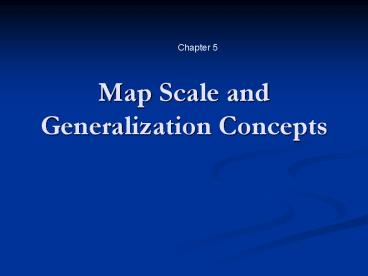Map Scale and Generalization Concepts - PowerPoint PPT Presentation
1 / 18
Title:
Map Scale and Generalization Concepts
Description:
... their visibility (Highway width on US map, to see clear need exaggeration) ... e.g.: highway shown on a US map with scale 1 : 10,000,000 with line 0.5 mm would ... – PowerPoint PPT presentation
Number of Views:335
Avg rating:3.0/5.0
Title: Map Scale and Generalization Concepts
1
Map Scale and Generalization Concepts
Chapter 5
2
Scale
- Scale is the relationship between distance on the
map and distance on the ground. - Selecting the appropriate scale depends on the
size of the sheet of paper and the accurate
placement of features. - http//www.beg.utexas.edu/GIS/tools/scale2.htm
3
Type of Map Scale
- Word Statement
- Representative Fraction
- Graphic Scale
4
Word Statement
- A word statement gives a written description of
scale, such as "One centimeter equals one
kilometer" or "One centimeter equals ten
kilometers." - Ineffective if the map is reproduced by a method
such as photocopying and the size of the map is
modified (Enlarge or Reduce)
5
Representative Fraction
- A ratio or representative fraction (RF) indicates
how many units on the earth's surface is equal to
one unit on the map. It can be expressed as
1/100,000 or 1100,000. - Good when Enlarge and Reduce complete map
6
Graphic Scale
- It is simply a line marked with distance on the
ground which the map user can use along with a
ruler to determine scale on the map. - Good when Enlarge and Reduce complete map
- In the U.S., a graphic scale often includes both
metric and U.S. common units.
7
How to Measure Distances on a Map?
- Find the scale for the map you're going to use -
it might be a ruler-looking bar scale or a
written scale, in words or numbers. - Use a ruler to measure the distance between the
two places. If the line is quite curved, use a
string to determine the distance and then measure
the string. - If the scale is a representative fraction (and
looks like 1/100,000 or 1100,000), multiply the
distance of the ruler by the denominator, giving
distance in the ruler units. - If the scale is a word statement (i.e. "One
centimeter equals one kilometer") then determine
the distance. - For a graphic scale, you'll need to measure the
graphic and divide the scale into the measured
units on the ruler. - Convert your units of measurement into the most
convenient units for you (i.e. convert 63,360
inches to one mile) - Tips
- Watch out for maps that have been reproduced and
have had their scale changed. A graphic scale
will change with the reduction or enlargement but
the other scales become wrong.
8
Large Scale Small Scale
9
Large Scale Small Scale
10
Large Scale Small Scale
11
Large Scale Small Scale
- Large scaleLarge representative fraction
(150,000 or Larger) - More detail
- Covers smaller spatial area of Earths surface
- Intermediate Scale150,000 to 1250,000
- Small Scale1250,000 to 17,500,000
- Less detail
- Covers larger spatial area of the Earths surface
12
Scale Determination
- When map dont have scale on map, then
- Use of known features
- Reference features as Football ground, tennis
court, Baseball diamond - Use of line of Latitude and Longitude
- Distance of 10 line of latitude is 111.133 km
(average) can be useful to determine scale on
ATLAS maps. - Use of Map Comparison
- Another map from same area, having similar
features can be helpful to determine scale.
13
Scale Conversion
- Map scales can be converted from one form to
another - RF to word-statement conversion
- Puts map scale in a form that is more easily
understood verbally - 163,360 is that same as saying 1 inch is 1 mile
- Word statement to RF
- 2 inches per mile is the same as 131,680
- RF to graphic conversions
- Graphic conversions to RF
14
Scale Conversion
15
Generalization
"The process of generalization requires the
selection of those features that are essential to
the map's purpose and the representation of them
in a way which is clear and informative".
- Selection
- Selection and retention of more important area
eliminating less important area. - Simplification
- Simplify the Shape of feature retain on maps with
changes in scale - Combination
- Combine similar Two or more features in one
symbol - Locational Shift
- Road or rail road or river crowded in to each
other, need shifting (not all features are shown
at their exact location) - Size Exaggeration
- Exaggerate the size of the objects to improve
their visibility (Highway width on US map, to see
clear need exaggeration)
16
Geometric generalization for Simplification
17
Simplification
- Simplify the Shape of feature retain on maps
18
Exaggeration
- On small scale maps most of the objects that are
important enough to be shown on the map but are
small in size in real life.e.g. highway shown
on a US map with scale 1 10,000,000 with line
0.5 mm would have to be 5,000 m wide in real life
to meet the proportional scaling criterion.































